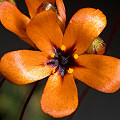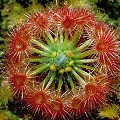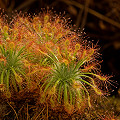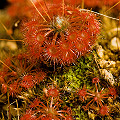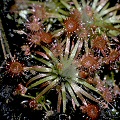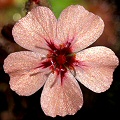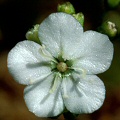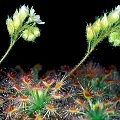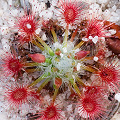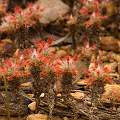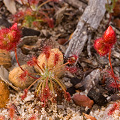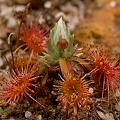Q: Pygmy Drosera
| Pygmy species of Australia and New Zealand1 | |
|---|---|
|
D. albonotata D. allantostigma D. androsacea D. australis D. barbigera D. bindoon D. callistos D. citrina D. closterostigma D. coalara D. coomallo D. depauperata D. dichrosepala D. echinoblastus D. eneabba D. enodes D. gibsonii D. grievei D. helodes D. hyperostigma D. lasiantha D. leioblastus D. leucoblasta D. leucostigma D. mannii D. micra D. micrantha |
D. microscapa D. miniata D. minutiflora D. nitidula D. nivea D. occidentalis D. omissa D. oreopodion D. paleacea D. patens D. pedicellaris D. platystigma D. pulchella D. pycnoblasta D. pygmaea2 D. rechingeri D. roseana D. sargentii D. scorpioides D. sewelliae D. silvicola D. spilos D. stelliflora D. trichocaulis D. verrucata D. walyunga |
|
1All pygmies are in section Bryastrum. 2Occurs across south Australia to New Zealand. |
|
A: The pygmy Drosera are almost all found only in Western Australia, a land of Mediterranean climate.
During the moist and cool winters, these plants flower and
grow in glandular spendor. Yet even in full growth they earn their nickname of "pygmy" sundews because they are
so tiny! Their leaves are often nearly microscopic in structure. Yet, while built on a tiny scale, they are delightful to
behold, like tiny jewels. I like 'em!
Pygmy Drosera flower freely, and their flowers are usually wonderful. Often they are
as big as the rest of the plant and are painted in brilliant or metallic
shades of white, pink, yellow, orange, and red. Very nice. Yes, I must admit that a few of the species have
nasty little white flowers, but these uglies are in the minority.
Unfortunately, pygmy Drosera flowers rarely produce seed, and the seeds that
do develop are extremely difficult to germinate. The hybrids in this group are usually sterile.
There is some taxonomic controversies regarding these species--the species have moved around from variety to subspecies back to species
and so on, like a grad student seeking a new apartment every year. Maybe...maybe things are finally settling down.
After the pleasant winter, a long hot summer follows. Pygmy Drosera plants enter a dormant state
to survive; their leaves die back and only the leaf stipules remain as
a shiny white bundle of hairs or bristles at the rosette center. This reflective bundle presumably keeps
the plant cool. There the plants sit, for many long hot months, awaiting the cool winter's return.
Growth in the fall resumes with the production of gemmae. Gemmae are modified leaves
which detach, root, and form new plants. They are produced from the rosette center, and look like a bundle of
little grapes or flat scales. They become so densely packed that the old leaf stipules are pushed away from the rosette center.
This acts like the cocking of a trigger---when a single raindrop strikes the mass of gemmae, the disturbance makes the
stipules flex back to their normal positions in an explosive burst, thus shooting the gemmae as far as a few meters! What an
interesting life history!
Cultivation of pygmy Drosera is not easily done in terraria; most find terrarium life
toxic. The exceptions are some of the hybrids, Drosera occidentalis, and
Drosera pygmaea. This latter species is the only
Drosera which is not
restricted to Western Australia, so it is not surprising it is comparatively easy to grow. You can cultivate
it in tropical sundew conditions. It also grows readily from seed---some might say
too readily since it can start colonizing other pots!
For best results, grow these plants in a sandy mix (2:1 sand:peat), in pots at least 15cm (6 inches) deep. Never try to transplant them,
as they have very long and delicate roots that mean a lot to them. Plant gemmae on the soil surface; orientation of the gemmae is
not important as they will figure out what to do no matter what way you have them situated. I like to have about 7-10 plants in a single
pot about 10cm across. The plants should mature from gemmae to flowering size in a single season.
The greatest stumbling block with this group of plants is getting them to survive through the long dry season. Often the
plants, especially ones more than a few years old, die during this time, but a few should survive to produce gemmae. Just in case,
you should have about 20 plants in at least two pots entering the summer season to ensure survival of at least one plant to produce
the gemmae needed in the spring.
By the way, I like to use tall plastic drinking cups with a few drill holes in the bottom as pots for pygmy sundews. These pots provide
plenty of root room, but don't require as much soil as normal, broad pots.
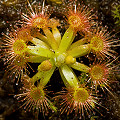 Drosera nitidula ×
Drosera nitidula ×
pulchella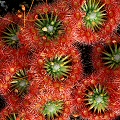 Drosera nitidula ×
Drosera nitidula ×
pygmaea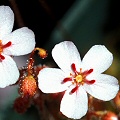 Drosera patens ×
Drosera patens ×
pulchella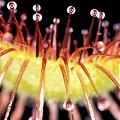 Drosera scorpioides
Drosera scorpioides
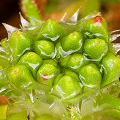 Drosera scorpioides
Drosera scorpioides
gemmae
I mentioned above that gemmae are dispersed via gemmae force. This can cause problems in cultivation---even if you do not
wish more plants, gemmae should be removed or else you will have volunteer plants growing
everywhere you do not want them. An excellent way to remove them from the plants is by using an
aspirator, a device well-known to entomologists.
The pygmy sundews are are described
in detail in Lowrie's books (see citation list below); these volumes are
essential to those interested in the group of plants. There has been some reshuffling of species names since they first appeared
in print.
Some of these reshufflings have caused contentious arguments. My own species lists have not been very
informed by field observations, as I have only seen pygmy Drosera in the field during three different trips...not
much to base an opinion on! So I have constructed my list of species with
arguments posed by field workers such as Lowrie, Mann, and Gibson.
My opinions on these plants, however, are quite mutable. The problem comes down to how much of a splitter you are when dealing with these
plants, which often seem to have a low fertility and which propagate strongly by vegetative means. Tiny (i.e., insignificant) differences
may be magnified by this, resulting in what might seem to be a separate species, when you are really just dealing with a monoclonal
population. What is a separate species? This is a heady topic.
Page citations: Lowrie, A. 1987, 1989, 1999, 2013; Lowrie, A. & Conran, J.G. 2007;
Lowrie, A. et al. 2017a, 2017b;
Mann, P. 2007; Rice, B.A. 2006a; Robinson, A. et al. 2017, 2018; Schlauer, J. 1996, 2002.
